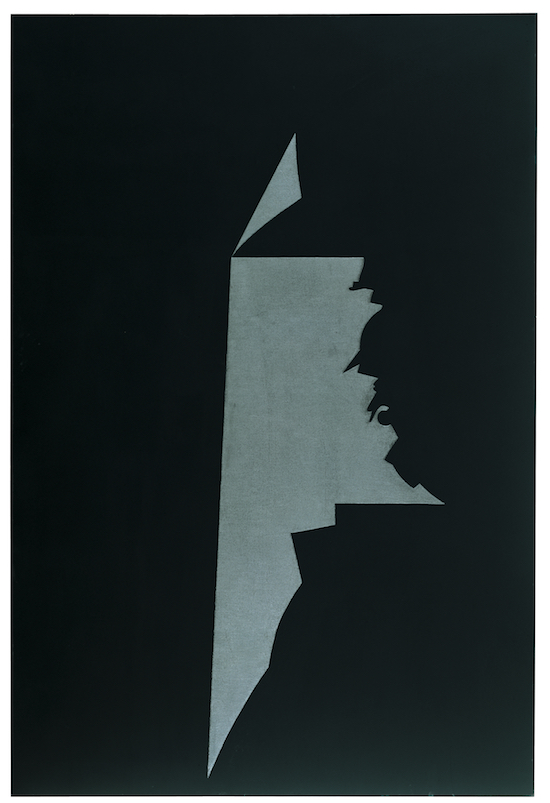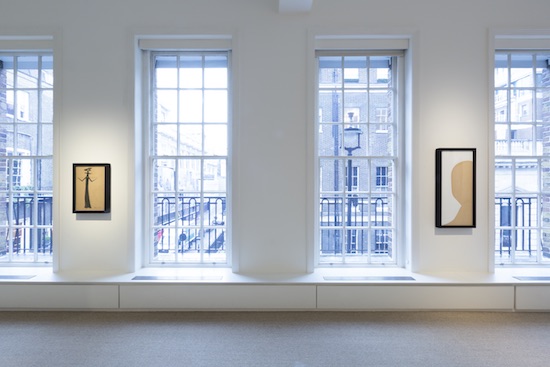Gino De Dominicis: Works from the Collection of Guntis Brands’, 2017. Courtesy of Luxembourg & Dayan. Photo: Will Amlot Photography © Estate of the artist / Archivio Gino De Dominicis, Foligno, Italy. DACS 2017
It is almost twenty years since the death of Gino De Dominicis – or is it? The artist who started his career with his own obituary in 1969 has played so freely with themes of death and immortality that many presumed, upon the announcement of his actual passing in 1998, that it was just another practical joke. As Marina Abramovic says, “his practice extended beyond the work itself into his life, and even into his death.”
Abramovic was talking at a recent panel discussion at the London gallery Luxembourg & Dayan where an exhibition of Dominicis’s paintings are currently on display. There is a playful, gothic quality to these works – shadowy images abound of quasi-supernatural figures with distorted features, twin mouths or long, beaked noses like Venetian carnival masks or figures out of a Jan Svankmayer film. But most of all these paintings reveal a determination to look at the world from a slightly different angle. When he paints portraits, his subjects are inevitably half-turned away. His nature morte shows us a fruit bowl as if viewed from below.
Throughout his career, De Dominicis moved from one medium to the next, taking in – as he himself once put it – “drawings, paintings, ‘sculptures’ (three-dimensional works), invisible works, ubiquitous works, architecture, and on some occasions, ‘physical oxymorons’ and ‘homeopathic’ works.” But as he later confessed, his true medium was “the secret”.
One might just as well say that – like Yves Klein – his aim, throughout was a leap into the impossible. Think of his early performance works, as documented on video in which he attempts to fly or produce square ripples from pebbles hurled into a pond. As fellow performance artist Abramovic puts it, “performance has so much to do with direct-energy dialogue that is generated by the artist’s person. And when the person dies, we must always ask, what is left? Well, the works and the objects of course, but in this case, also so much energy is left.”

GINO DE DOMINICIS (1947-1998)Con Titolo (Ghilgamesh), 1988Mixed media on panel97⅝ x 66⅛ in. (248 x 168 cm.)© Estate of the artist / Archivio Gino De Dominicis, Foligno, Italy. DACS 2017
The following text is an edited extract from Abramovic’s comments at the panel discussion at Luxembourg & Dayan on the 27 November last year:
I first met Gino in 1971. This was on the occasion of Achille Bonito Oliva’s Contemporanea exhibition. Those were very special times in Rome, and as a young artist I was very excited about the opportunity to meet all of these Arte Povera people in person. I remember that Mario and Marisa Merz were there too, and we stayed together in a very strange hotel, the Locanda, probably the cheapest hotel in Rome at the time. Marisa and I shared a room and Mario slept in a room on his own. Janis Kounelis, Luigi Ontani, and Emilio Prini were there as well. Rome was a very vibrant city in those days and we had this ritual where every night we would all go to Buccone to have a glass of wine, and then continue somewhere else for dinner, and finally, we would head to one of the artists’ studios to continue the conversation until the small hours of the morning.
Anyway, one of these evenings, I met Gino. At first, I absolutely did not connect him with the art scene. In fact, I thought that he was a croupier, or some kind of a gambler. He asked me if I smoke, and if he can have a cigarette. I must have handed him the pack because before I noticed, he held it open with his beautiful long fingers, very much like a card player, handed me one cigarette and took one for himself. He had a very wide face, and as I learned later, he was always dressed in elegant black clothes. Everything about him seemed so meticulous in the dark, but if for whatever reason you managed to see him during the daytime, you realised that his clothes were in fact completely worn out, shiny from over-use, and breaking apart. Anyway, that night, when I got back to my room at the hotel, I realised that he took my pack of cigarettes without me ever noticing. It was a strange gesture, so elegant that you wouldn’t notice, so perfect that it didn’t even feel wrong. Later I realised how much that gesture said about what his character was like, and what his art was about.
Gino was really penniless at the time when I knew him. And one night, while we were all together drinking in some bar, he approached a collector (whose name I won’t mention) and asked him if he would agree to buy ‘an invisible work of art from him. The collector agreed and wrote a check on the spot, not expecting to receive anything in return. Anyway, we all completely forgot about the whole thing, until a few weeks later an established art shipping company calls the collector to say that they have an ‘invisible work’ to be delivered to his home, inquiring when can they come by. The collector, stupefied, suggested a delivery time. When the day came, two art handlers arrived at his home with work coats and white gloves asking where can they install the aforementioned ‘invisible work’. The collector, not seeing anything in their hands suggested they place it by the window. The handlers refused, claiming the piece might be sensitive to light. Eventually, after some negotiation about the positioning of the work they pulled out a piece of masking tape, formed a square on the floor, and left. The work was later baptised Cubo Invisibile (1969) when it went on loan to Galeria L’Attico.
There is an incredibly important Sumerian sculpture of Gilgamesh in the Louvre, which I went to study a long time ago. The sculpture presents Gilgamesh as a demi-god next to a stream of water were one fish swims with the stream, and the other, against it. This seemingly marginal symbol, I believe, is the key to Gilgamesh as well as to Gino De Dominicis’ work – the idea of the impossible-possible; of the magic act; the divine energy; something that is not normal, that is supernatural. And this is what so much of Gino’s work is based on, as we can see here in the show in works such as Il Mago (The Magician, 1994). In a parallel world, De Dominicis could have equally been a magician for parties, a mortician in a funeral home, or both.
Gino De Dominicis, Works from the Collection of Guntis Brands, is at Luxembourg & Dayan, London, until 19 January


